Stained Glass Windows
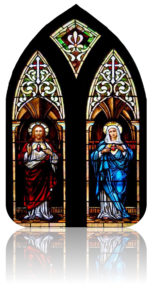
Sacred Heart of Jesus—Immaculate Heart of Mary—“Blessed be the Most Loving Heart and Sweet Name of Our Lord Jesus Christ and the most glorious Virgin Mary, His Mother, in eternity and forever. Amen.”
… Only the Heart of Christ who knows the depths of his Father’s love could reveal to us the abyss of his mercy in so simple and beautiful a way. …
This is certainly the most beautiful of the windows at Sacred Heart. When the morning sun shines through these two, it is difficult not to look. And all who do must surely feel the presence of God. We have two other, smaller windows with the Sacred Heart and the Immaculate Heart, which shows the special focus the first members of our church, had on its namesake.
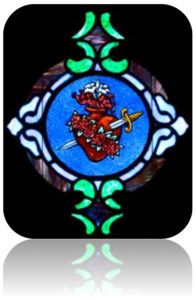
Immaculate Heart of Mary—“Pure heart of Mary: Pierced with a sword of sorrow” The Immaculate Heart of Mary, seen on countless statues and holy pictures, is one of the most fundamental symbols of pure Divinity by which Our Lady Mary is identified as Our Mother of God. Traditionally, the heart is pierced with seven wounds or swords, in homage to the seven sorrows of Mary. Consequently, seven Hail Marys are said daily in honor of this devotion.
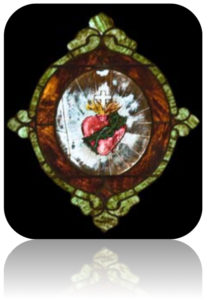
Sacred Heart of Jesus—The Sacred Heart of Jesus is today one of the most recognizable symbols of the Catholic faith. The image originated in France near the end of the seventeenth century when a nun named Marguerite Marie Alacoque (Often Anglicized to Mary—Margaret) began to publicize her mystical visions of Jesus, who admonished her to devote herself and the country to the veneration of his heart.
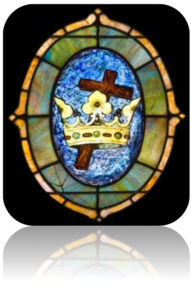
Cross and the Crown—“The sufferings of life lead to the glory of Heaven.” The relationship between the cross and the crown was first displayed at the crucifixion itself. That relationship was a poignant contrast: a Roman placard declaring that the bloody, writhing victim on this pole was the king of the Jews. That relationship provoked mockery: “If you are the king, come down from the cross!” The cross with the crown depicted at an angle (St. Gilbert’s Cross), is also as it would have been when Jesus dragged it up the mound at Golgotha.
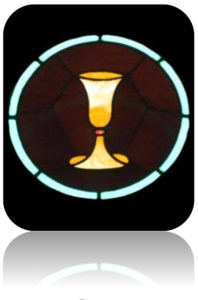
Chalice of Communion—The word chalice comes from the Latin word ‘calix’ meaning cup. The name of the cup used in the sacrament of the Lord’s Supper. The chalice is a symbol of Holy Communion and the forgiveness of sin won by Christ’s blood shed on the cross.
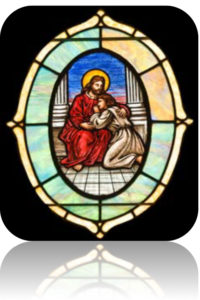
Jesus receives and embraces a repentant “Sinner”— In the sacrament of penance and reconciliation, we meet the Lord, who wants to grant forgiveness and the grace to live a renewed life in him. In this sacrament, he prepares us to receive him with a lively faith, earnest hope, and sacrificial love in the Eucharist. By the grace of the Holy Spirit, we repent, let go of any pattern of sin, grow in the life of virtue and witness to a joyful conversion.
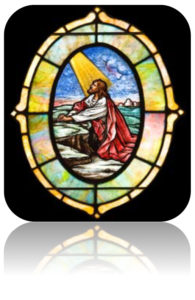
Praying in the Garden of Gethsemane—“My Father, if it is possible, let this cup pass from me; yet, not as I will, but as you will” (Matthew 26:39).—Then Jesus came with them to a place called Gethsemane, and he said to his disciples, “Sit here while I go over there and pray.” He took along Peter and the two sons of Zebedee, and began to feel sorrow and distress (Matthew 26:36-37). This image shows the spiritual struggle between the two sides of Jesus’ nature, the human that feared suffering and wanted to avoid it, the divine that gave him strength. (Gethsemane) means in Hebrew ‘oil press’. The ‘garden’ was an olive grove.
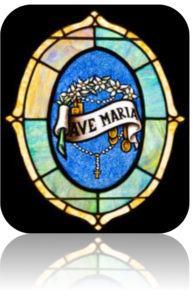
Luke 1:28. … Hail Mary—“Hail Mary, full of grace, the Lord is with you.” These are the words spoken by God and delivered to us by the angel Gabriel (who is a messenger of God). Thus, when we Catholics recite this verse while praying the Rosary or any other time, we are uttering the words of God.
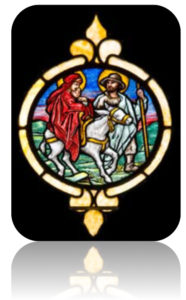
Baby Jesus, Mary and Joseph Flight into Egypt—“Rise, take the child and his mother, flee to Egypt, and stay there until I tell you. Herod is going to search for the child to destroy him” (Matthew 2:13-23). When the Magi came in search of Jesus, they go to Herod the Great in Jerusalem and ask where to find the newborn “King of the Jews”. Herod becomes paranoid that the child will threaten his throne, and seeks to kill him by slaughtering all male children. An angel appears to Joseph and warns him to take the baby Jesus and his Mother to Egypt. Joseph leads the donkey with Mary tenderly caressing the Christ child.
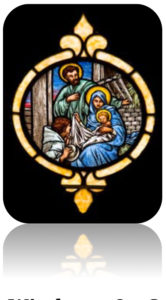
The Birth of Christ—“She wrapped him in swaddling clothes and laid him in a manger, because there was no room for them in the inn.” Born in a manger, Jesus came to save humankind from sin. The nativity scene is truly the meaning of Christmas and why we celebrate this day. Without it, none of Christmas and its traditions would have evolved into the special day that it has become.
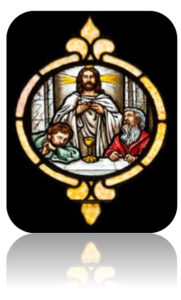
The Last Supper/First Communion—“Take this, all of you, and eat of it:” (Words of Institution—Matthew 26:26). Jesus purposefully arranges for the Last Supper to be held on the eve of the Jewish Passover with all twelve disciples in attendance. recorded in three of the four Synoptic Gospels (e.g., Matthew, Mark, and Luke), Jesus fully realizes that His suffering from betrayal is immanent and that His life on earth will soon be at an end. During the meal, Jesus gives His disciples symbols of remembrance of His sacrificed body and blood.
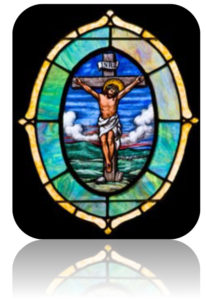
The Crucifixion—“Father, forgive them, they know not what they do.” (Luke 23:34). The crucifixion of Jesus Christ is discussed in all four Gospels of the New Testament. Carrying his cross up the rugged and desolate hillside of Golgotha to the site of His execution, Jesus is bound and nailed to a tree by His hands and feet. He is left to hang on the cross for three hours before succumbing to death.
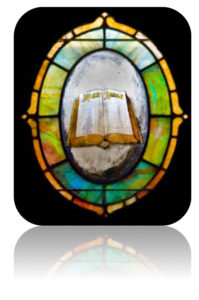
The Holy Bible—“God’s Word”—We believe that the Bible is the Word of God and that it is a collection of writings detailing the journey of Gods relationship with Gods people across generations. It is the sacred story of our faith and every time we gather to celebrate a ritual or a sacrament in the church, the word of God is central to that celebration.
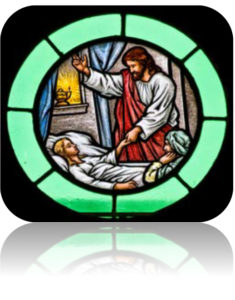
Healing the daughter of Jarius—“Little girl, I say to you, arise!” (Mark 5:41). Jairus, a patron of the synagogue, asks Jesus to heal his dying daughter. However, according to Matthew (Matthew 9:18-26), his daughter is already dead, not dying. As they travel to Jairus’s house, a sick woman in the crowd touches Jesus’ cloak and is healed of her sickness. This is called the miracle of Christ healing the bleeding woman. Jesus continues to the house and brings her back to life, or in his own words, awakens her. Faith, especially as embodied by the bleeding woman, can exist in seemingly hopeless situations.
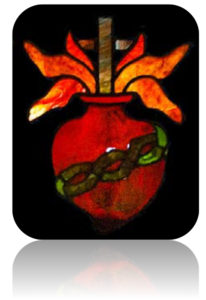
Most Sacred Heart of Jesus—Represents Jesus’ physical heart and the unmitigated love, compassion, and long—suffering of the heart of Christ towards humanity. This glass shows a flaming heart shining with divine light, pierced by the lance—wound, encircled by the crown of thorns, and surmounted by a cross and bleeding.

The Good Shepard—Throughout the Holy Scriptures, Jesus is often described as a shepherd. When Jesus speaks to the Pharisees in John 10:1-5, He introduces the Parable of the Good Shepherd. The Lord also describes Himself as a door that opens to the sheepfold in John 10:7. Jesus uses the Parable of the Lost Sheep in Matthew 18:10-14 and Luke 15:1-7 to describe how a shepherd will go to any length to ensure the safety and well being of his flock.
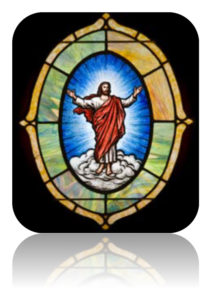
The Ascension of Jesus—“The Lord ascends into Heaven,” Acts 1:9-11, in which the resurrected body of Jesus is taken up into the clouds before the witnessing eyes of His eleven disciples. The imagery of the Ascension is particularly dynamic in that the risen Christ is viewed as disappearing into the clouds as He extends His arms in a final gesture of blessing before returning home to the Father.
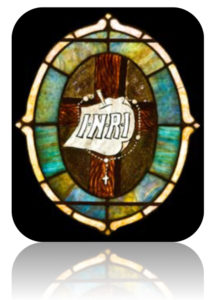
INRI—(Iesus Nazarenus, Rex ludaeorum)—“Jesus the Nazarene, King of the Jews” The INRI Christian Symbol represents an acronym of this Latin phrase, the inscription that Pontius Pilate ordered placed on Jesus’ cross.
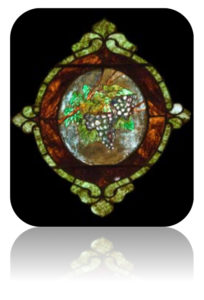
The Vine and the Branches—“I am the vine, you are the branches. Whoever remains in me and I in him will bear much fruit, because without me you can do nothing” (John 15:5). The Sacred Scriptures use this image of the vine in various ways. In a particular case, the vine serves to express the Mystery of the People of God. From this perspective, which emphasizes the Church’s internal nature, the lay faithful are seen not simply as laborers who work in the vineyard, but as themselves being a part of the vineyard.
